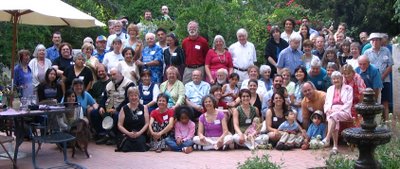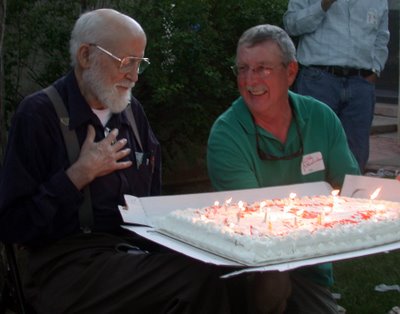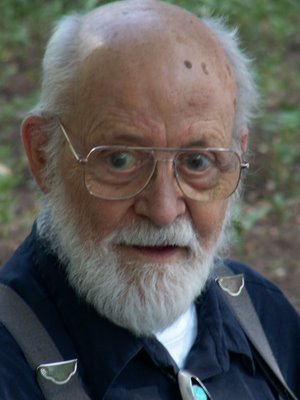This will be a place for random thoughts and musings, family news, and notes about travels, and everyday life -- an experiment.
Sunday, July 30, 2006
Wednesday, July 26, 2006
Commonplace Book: Reflections on Old Age and Death
What is there in literature that prepares us for this? What kind of story can one create about gradual decline, increasing disability, and eventual death? There’s no gripping plot here. The obstacles tend to involve medical interventions that will temporarily postpone inevitable death, and allow a bit of fairly good living for a little longer.
and deeper till the very end, gaining strength and getting more precious all the way. . . .
http://www.poets.org/viewmedia.php/prmMID/16971
Dylan Thomas, in his wonderful voice, reads "Do Not Go Gentle into that Good Night":
http://www.poets.org/viewmedia.php/prmMID/15377
there is also a copy of the poem and a reflection on it:
http://webpages.charter.net/classicpoetry/dtdonotgogentle.htm
But, I’m not willing to give up the search for fiction, yet, perhaps from other cultures? Suggestions welcome!
Monday, July 17, 2006
Sunday, July 16, 2006
Choosing a Camera
I finally ordered a camera (Canon Cybershot A620) this morning, after spending several days exhaustively (and exhaustingly) reading online reviews. There are several sites that review in more depth than most people could ever want. I googled digital camera reviews (did you see that google as a verb is now being included in new dictionaries?), and came up with at least these:
www.steves-digicams.com
www.imaging-resource.com/
www.dcviews.com
www.dcresource.com/
plus Cnet, and several others.
To tell the truth I'm not quite sure what I was looking at all times. There may be some overlap in the above addresses. I also tapped into some discussion forums, but they tend to be pretty scattered. I found Steve's (at least a name to latch onto on that one), and one of the DC sites to be excellent (reviews by Jeff and maybe others). In fact, I think I'll go back and print the reviews of the camera I bought. Some of them also have online tutorials, and you could practically use the sites as manuals (no printed manual for this camera) since they show every button and dial and tell how each is used.
I printed pages and pages of stuff, and went through a long question/answer routine which was supposed to pick the best camera for me, but I don't think the camera I picked was on any of those lists, although I changed my answers several times to see what different recommendations would come up. My other choices did tend to come up as one of the 20 cameras, but never at the top of the list.
Finally I narrowed my choices to four possibilities: the Canon A620 (and possibly the A700), the very small Canon Powershot SD700 IS (a beautiful little thing, costing close to $500), and in the similarly priced Canon Powershot S3 IS 12x zoom, and the very similar Sony Cybershot DSC H5. Two salesmen at
The SD700 IS was quite wonderful, but when I thought of spending that much money, I had the feeling I wanted something that felt more like a "real" camera. I did look at the SLRs, but decided there is no way I'm ready for them at this point -- nor do I want to go backpacking with them. I was also considering the somewhat newer Canon A700, which has a 6x zoom and a larger LCD display. In truth, I've never used the LCD display for photographing, only for playback. I can see its advantages, but after a lifetime of holding cameras up to my eye, that feels best to me, and I feel it is so much easier to hold the camera steady. The tiny, not very sharp viewfinder was one thing that turned me away from the small SD700 IS, plus, as some reviewers pointed out, when you do put it up to your face, your nose smudges that beautiful large LCD display. The A620 had a great viewfinder, and what I am excited about is the articulated LCD display -- maybe I now will use it. It also will show grid lines so you can level your horizons. As I read further in reviews I found out that the viewfinders on most cameras is slightly askew, which is why I keep having to edit pictures to straighten them -- so if it looks straight in the viewfinder, on Ed's Canon A75, for example, it is actually leaning a bit to one side, so everything will be tilting a little in the picture. For some reasons, putting together all these slide shows, these crooked pictures have been driving me nuts. I really notice them. It is like walking into a house and feeling compelled to straighten all the pictures hanging on the walls.
Using the LCD would help with that. I also like the articulated LCD because when it is closed up, there's no surface to scratch. Also the lens closes up when you turn the camera off -- no lens cap to worry about, so I will be able to just throw the camera into my purse or backpack or suitcase, or stick it in the bag with the binoculars, and I won't have to worry about anything getting scratched. I like that. No extra case is necessary. The lens cap on my
I have compromised on a kind of middle-of-the-road camera. I hope it will feel small enough so that it will be as easy to take along as to leave home (although not as small as the cell-phone, pack of cards-sized SD700), and that the 4x zoom and 700 mega pixels will be enough to keep me fairly happy. If not, since I've just paid $229 for this camera (online from PCRush.com), I can still afford to buy one of the 12X zooms -- and maybe in another few months or a year, they'll have made a few more improvements and have some of the bugs worked out. One drawback with the Sony was that at high zoom it got "purple fringing." The example is not nice -- but then that probably won't happen that often. It also fell down on the "burst" shooting when you can set it to do many pictures in a row. On the plus side, it had Sony TV quality video capabilities with the ability to zoom while shooting a video, which would be nice, and a very long flash, which one reviewer put as a negative, however. The Canon had the articulated, although smaller, LCD, and Canons do have an excellent reputation..
Batteries: Another factor in my decision was battery type. The very small cameras cannot, of course, use AA batteries. The others I looked at do. This means you can pick up substitute batteries anywhere, anytime, if you accidentally run out of power (as I did once in a tiny village in
Shutter Lag: The shutter lag has apparently improved on almost all digitals. The lag time is reported to be .7 of a second, which sounds pretty good to me. It turns out the A620 is a #1 camera in popularity on several lists, and was at the top of the list in Consumer Report's ratings of compact cameras. I suppose I could have stopped research after reading Consumer Reports and saved myself several days of work. Ed says, "That's the camera I suggested you buy about 2 weeks ago!" But, of course, I had to look at everything.
The two 12x zooms are too new to be listed in CR. The predecessor to the Canon (which lacked image stabilization -- a very good thing to have) got very high marks. I still may spring for one of the 12xs in the future if I feel a need for a 12x zoom. The cameras are not nearly as bulky as SLRs, and will do several things SLRs will not do. As for differences in quality, I suspect that for most of us, in most instances, we are not going to see the difference. I did read what the NYTimes news photographers use -- top end professional Canons that cost $7,000 to 10,000. I think that is moving into another realm. I read a "professional" review of another SLR that costs "only" between $3,000 and $4,000. It was judged well worth the price and would "pay for itself" in no time. I guess if you want the ultimate in high zoom plus high light-gathering lenses, and high speed, and high resolution, which you would want for news photos, and maybe not too much weight, you have to pay for it.

Saturday, July 8, 2006
Commonplace Book
Saturday, July 08, 2006
Commonplace Book
This is where I am putting quotations that are meaningful to me, and my comments on them.
I Corinthians 13:1-13
New Jersusalem translation
If I speak in the tongues of mortals and of angels, but do not have love, I am a noisy gong or a clanging cymbal. And if I have prophetic powers, and understand all mysteries and all knowledge, and if I have all faith, so as to remove mountains, but do not have love, I am nothing. If I give away all my possessions, and if I hand over my body so that I may boast, but do not have love, I gain nothing.
Love is patient; love is kind; love is not envious or boastful or arrogant or rude. It does not insist on its own way; it is not irritable or resentful; it does not rejoice in wrongdoing, but rejoices in the truth. It bears all things, believes all things, hopes all things, endures all things.
Love never ends. But as for prophecies, they will come to an end; as for tongues, they will cease; as for knowledge, it will come to an end. For we know only in part, and we prophesy only in part; but when the complete comes, the partial will come to an end. When I was a child, I spoke like a child, I reasoned like a child; when I became an adult, I put an end to childish ways. For now we see in a mirror, dimly, but then we will see face to face. Now I know only in part; then I will know fully, even as I have been fully known. And now faith, hope, and love abide, these three; and the greatest of these is love.
"Love is patient" are words that came to me in our cancer caregivers' writing group yesterday afternoon as we wrote on the topic of "patience." None of us were sure where the words came from, but we all knew them. I realize that one reason I didn't immediataely recognize the source is that I'm more familiar with the traditional King James version in which love is called "charity" and instead of love being "patient," "Charity suffereth long and is kind."
Although I know the other translations, also (of the Greek agape). There are so many phrases in this letter of Paul to the Corinthians that are mainstays of my thinking. It comes as a bit of a shock to realize they are all here together in this one place.
Two other quotations came to me as I was writing, that seemed related to "love is patient." The first of these was Shakespeare's sonnet that begins, "Let me not to the marriage of true minds..." and the other was the "Serenity Prayer" attributed to St. Francis, although his authorship is disputed.
Sonnet 116
Let Me Not to the Marriage of True Minds
Let me not to the marriage of true minds
Admit impediments. Love is not love
Which alters when it alteration finds,
Or bends with the remover to remove:
O, no! it is an ever-fixèd mark,
That looks on tempests and is never shaken;
It is the star to every wand'ring bark,
Whose worth's unknown, although his heighth be taken.
Love's not Time's fool, though rosy lips and cheeks
Within his bending sickle's compass come;
Love alters not with his brief hours and weeks,
But bears it out even to the edge of doom:
If this be error and upon me proved,
I never writ, nor no man ever loved.
Hmm. I find out this not St. Francis, but Reinhold Niebhur, and that there are many versions of this prayer, supposedly written on July 1, 1943. There's an extended discussion in Wikipedia
http://en.wikipedia.org/wiki/Serenity_Prayer
God, grant me the serenity to accept the things I cannot change;
courage to change the things I can; and
the wisdom to know the difference.
Living one day at a time;
enjoying one moment at a time;
accepting hardship as the pathway to peace.
Taking, as He did, this sinful world as it is, not as I would have it.
Trusting that He will make all things right, if I surrender to His will.
That I may be reasonably happy in this life,
and supremely happy with Him forever in the next.
All of these quotations are related to the topic of "love and patience."
These historical authors are so much more real to me now that I've visited
Now what is the St. Francis prayer of which I'm thinking?
http://www.reference.com/browse/wiki/Prayer_of_Saint_Francis
Prayer of Saint Francis
The so-called Prayer of Saint Francis is a Christian prayer widely attributed to the 13th-century saint Francis of Assisi, although it cannot be traced back further than the 19th century.
Lord, make me an instrument of Thy peace;
where there is hatred, let me sow love;
where there is injury, pardon;
where there is doubt, faith;
where there is despair, hope;
where there is darkness, light;
and where there is sadness, joy.
O Divine Master,
grant that I may not so much seek to be consoled as to console;
to be understood, as to understand;
to be loved, as to love;
for it is in giving that we receive,
it is in pardoning that we are pardoned,
and it is in dying that we are born to eternal life.
Amen.
Interestingly this, like the "Serenity Prayer" is also used by Alcoholics Anonymous. I suppose that fighting against addiction is not too different from fighting to live with an incurable disease, or with any distressing circumstances beyond one's control.
An excerpt from my notebook: "Perhaps just as bravery isn't about not being afraid, but being brave in the face of fear, maybe patience isn't about being accepting and calm, but being patient in the face of panic, anger, frustration, and sorrow."
Friday, July 7, 2006
Ed's Eighty Trips around the Sun
Thanks again for including us in the big celebration of Ed's 80th. Your party made it very evident that the two of you are truly loved by your large family and many friends. --Eleonor Hellman and Bruce Blossman (Santa Fe)
We enjoyed getting to know some of your friends we’d never met before …. Mary Kay, Susan, and especially Craig…as well as catching with those we did know…the weekend made me think of “Camelot” – “for one, brief, shing moment…” so many people came together from so far just to be joyful… We hope the warmth of those great 3 days will stay with you throughout the year, especially when there are “bumps in the road.” – Karen Nystrom (Fort Collins, CO)
Uncle Ed, you are very special and I wanted so much to come and was glad it all worked out! Now you and I have work to do to get better….I had a good trip back; managed a business class upgrade and slept for 7 of the 11 hour flight. The woman behind me asked what drugs I took and I just told her it was a great celebration weekend with family, thus I was exhausted. The best kind of drugs! -- Maggie Scheid (who came all the way from England)
It was the most beautiful party I have ever attended, I think, and my appreciation of you, and your love for Ed, only increases! -Eleanor Schick (Albuquerque)
I'm still sharing with Dawn the happy memories of the three parties last week. I have never in all my days been a part of such an extended and happy birthday celebration. – Craig Werner (Buffalo, NY)










